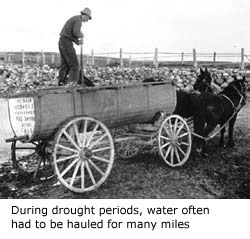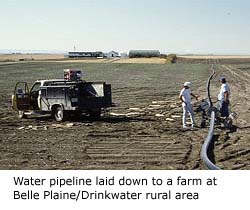

It has been said that water is liquid gold on the Canadian Prairies. It is frequently difficult to secure water for agriculture and other purposes. In 1937, Regina received less than 23 cm of rainfall and record high temperatures were set across the Prairies. The total value of grain produced in Saskatchewan that year was less than 10 percent of what it had been in 1928.
Rainfall generally is insufficient to maintain flowing streams, natural lakes, springs and shallow wells. Streams originating within the prairie region flow only during the spring thaw or after very heavy rains. Reliable supplies of water are available in the rivers flowing from the Rocky Mountains, but these rivers are located only at wide intervals throughout most of the prairies. Also, they flow in deeply entrenched valleys, which present an effective barrier to their utilization.
Attempts have been made to solve this problem since the very earliest days of settlement on the prairies. To obtain a dependable supply of water, farmers have had to go to the relatively heavy expense of sinking deep wells or of transporting water from distant sources.
Several means of storing runoff water and using it for irrigation were developed at a very early stage of agricultural development, particularly by ranchers in the short-grass plains area. Consequently the use of small dams, weirs and dugouts for storing water was necessary in this water shortage region. Other early water developers were the railway companies, who had to establish water supplies for the steam locomotives. Many of the railway storages throughout the prairies were turned over to local interests -- some after serving the railway for 80 years.
Some assistance in water development was provided to early settlers by the Reclamation Service of the old Department of Interior. This was mostly in the form of engineering services for developing irrigation projects, particularly in the open plains area where winter feed for cattle was a primary requirement in the ranching business.
In 1942, a special post-war reconstruction committee had identified 42 possible water development projects in western Canada. In 1946, investigations began for a number of identified projects including dam sites along the Red Deer, South Saskatchewan, and St. Mary Rivers and construction on the St. Mary Irrigation Project began, as well.
The initial program was concerned with helping farmers receive better water supplies by means of dugouts and stockwatering dams that store runoff water from the spring snowmelt. Initially $250,000 was allocated for water development projects. Financial assistance allocated to farmers was $50 for dugouts, $150 for stock-watering dams and flood irrigation schemes, and $350 for irrigation dams.
In the early days, the program focused on dugouts and dams, but has since been modified to cover a range of water supply projects . Assistance for wells was added in the 1973 and rural pipelines in 1981. More recently projects with water quality and environmental concerns were added in 1990s.
Today, the RWDP has expanded to provide funding to many different projects. The maximum
financial contribution to any one recipient for a project is $1 million. Such larger projects are
usually
undertaken in partnership with provincial governments.

For individual water development projects, financial assistance is provided under PFRA on a self-help basis to cover only part of the construction costs, and applicants are responsible for the construction. Financial assistance is payable to applicants when works is completed to conform to provincial water rights regulations and to plans and specifications approved by PFRA. Individual projects consist of dugouts, stockwatering dams and irrigation works. These are developed to provide water on individual farms from the smaller streams and local runoff. Individual projects may be supplemented in some areas by small community projects which are usually operated by a municipality.
Larger projects are usually constructed by contract and the total cost paid by PFRA. These include storage and irrigation works on large rivers and streams and are intended to serve community needs and provide for rehabilitation on a community scale. An important part of the RWDP was the development of regional water supply systems that serve neighbouring small rural communities and groups of farmers through a network of buried water pipelines.
Between 1935 and 2000, the RWDP provided technical and financial assistance on 148,417 dugouts, 111,552 wells, 14,839 stock-watering dams, 10,723 irrigation projects, 847 medium and large dams, and 711 water pipelines. Most are owned and maintained by the individuals or communities using them.
Water development projects on the Prairies have resulted in appreciable benefits to
agriculture on the Canadian prairies. The main benefit has been to the livestock industry by
creating or
improving water facilities on farms, pastures and feed lots and through the production of reserve
supplies of
forage grown under irrigation. Many projects led to an almost entirely new approach to dryland
farming. Techniques in soil management which make more efficient use of limited
supplies of soil moisture have been developed and in common use. This helped to minimize the
drought
problem and bring farming practices more in line with prevailing soil and climatic conditions in
the drier
areas.